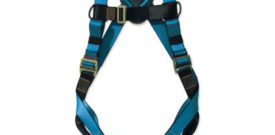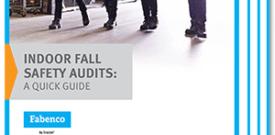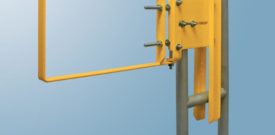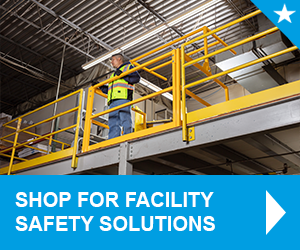
Looking for a simple way to keep production running at an all-time high? Provide your employees with adequate fall protection. It’s not only a way to keep your production processes humming along, it’s also a requirement under Federal OSHA regulations. As an employer, it’s your duty to both identify fall risks and take appropriate action to minimize or eliminate them with the use of active and/or passive fall protection. When used in conjunction, active and passive fall protection ensures your employees are able to safely complete their jobs and focus their attention primarily on the tasks at hand. Save yourself hours lost and evaluate worksite safety in your warehouse, shipping yard or office space using the steps below.
Fall Risk Evaluation![Dowload the Indoor Fall Safety Audit Guide]()
Identifying fall risks requires a thorough inspection of the facility and a detailed evaluation of the areas that are most dangerous. Key areas to focus on include elevated walkways, loading docks, stairways, and rooftops. However, these are not the only areas that pose a fall risk. Every facility has a unique layout and it is necessary to evaluate every aspect of the building, including processes and procedures, to determine existing threats and how to diminish them.
Areas to evaluate include, but are not limited to:
- Elevated areas
- Mezzanines
- Stairways
- Loading Docks
- Areas Above Equipment & Machinery
- Leading Edges
- Roof Openings
Eliminating Fall Risks
The best way to minimize fall hazards is to eliminate them. Through the course of an inspection, evaluate why your workers might be exposed to a fall hazard in the first place. Are they climbing ladders instead of using a stairway? Is there equipment or machinery in an area that might require some fancy footwork to get by? Are there exposed edges or gaps on any walking or working surfaces? Is there a general knowledge of safety protocol among your employees? How you respond to these questions may mean you have some changes to make.
Fall Protection Devices
When hazards cannot be eliminated, fall protection systems must be used to minimize the potential for slips and falls. These devices can be identified as either passive or active and each type is governed by OSHA standards and regulations. Understanding the difference between active and passive fall protection — and when they’re most appropriate — is the first step to improving workplace safety conditions.
Passive Systems:
Passive fall protection systems exist as part of your workspace layout, and do not require any interaction from the worker once they are installed. Guardrails, netting, and safety gates are excellent examples of passive fall protection devices. When properly installed, passive fall systems are ready to prevent and stop falls at all times.

Active fall protection systems require action on the part of the user. Fall protection harnesses and safety lanyards are good examples — they require inspection and adjustments, and the user must put it on, anchor it, and make sure they are using it properly each time fall prevention is required.
Passive systems are generally used in high traffic areas such as mezzanines, walkways, loading docks, and stairways. Active systems are most often used in lower traffic areas and anywhere that passive systems can’t be used — for example, when guardrails and a safety gate aren’t feasible due to the variable conditions of the workspace.
Combining Passive & Active Systems
In some cases, the best way to protect workers from fall hazards is to combine passive and active fall protection devices. For example, an employee above dangerous equipment would benefit from passive devices like a safety gate or guardrails, as well as active devices like fall protection harnesses and safety lanyards. While one device may seem sufficient, the combination of the two offers extra insurance against slips, trips, and falls — especially if one of your devices fails.
Fall Prevention vs Fall Arrest
It may be tempting to simply label passive and active fall protection devices as fall prevention and fall arrest, respectively. On the surface, it’s easy to misconstrue passive devices as fall prevention, and active devices as fall arrest. This isn’t true, however. A fall arrest stops a fall once it’s begun, fall prevention keeps it from ever happening at all.
For example, guardrails, safety gates, and safety nets are all passive fall systems. A guardrail or a safety gate is considered fall prevention — they prevent falls from occurring. However, a safety net is a fall arrest device — it stops a fall once it’s started. Likewise, fall protection harnesses, safety lanyards, and travel restraint systems are all considered active fall prevention devices. While harnesses and lanyards stop a fall mid-way (fall arrest), travel restraint systems prevent you from reaching the fall hazard at all (fall prevention).
Protecting employees in the workplace is a serious matter for employers for some very important reasons. First and foremost, employee well-being is at stake. Putting safety high on your priority list not only prevents injuries, it shows your employees you care more about them than the bottom line. Second, fall protection is required by OSHA, and non-compliance can land a company in serious hot water. Fines, penalties, loss of productivity, and damage to a brand’s reputation can have a devastating financial impact.
Safety begins at the top, and as a leader, it is your responsibility to enact company-wide safety protocols and best practices. Creating a written safety manual and distributing it to employees is a good start. Providing them with adequate on-going safety training and regular performance evaluations is another good step. But even with the best training, falls can still occur. Therefore, providing proper safety equipment is a must. Be proactive and evaluate your facility. Identify the hazards, eliminate those you can, and then minimize further risk by incorporating both passive and active fall protection devices into your safety protocol.










